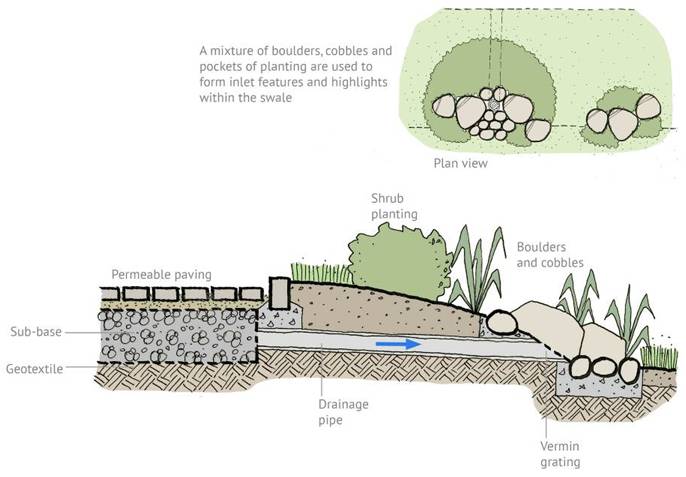- Delivering SuDS
- Using SuDS
- Background
- SuDS principles
- Benefits of SuDS
- Benefits of SuDS
- Why developers should choose SuDS
- Flood risk management
- Water quality management
- Biodiversity & ecology
- Amenity
- Air quality
- Building temperature
- Carbon reduction and sequestration
- Crime
- Economic growth
- Enabling development
- Flexible infrastructure/climate change adaptation
- Education
- Groundwater recharge
- Health and well being
- Pumping wastewater
- Rainwater harvesting
- Recreation
- Tourism
- Traffic calming
- Treating wastewater
- SuDS components
- SuDS components overview
- Source control
- Swales & conveyance channels
- Filtration
- Infiltration
- Retention & detention
- Wetlands
- Inlets, outlets and control structures
- SuDS performance & monitoring
- Delivery
- The costs & benefits of SuDS
- Adoption & maintenance of SuDS
- Legislation & regulation
- Design guidance
- Retrofitting SuDS
- Drainage exceedance
- Home
- Delivering SuDS
- Using SuDS
- SuDS components
- Inlets, outlets and control structures
- Inlets, outlets & control structures overview
Inlets, outlets & control structures overview
Inlets, outlets and control structures are important components of well design SuDS schemes. They allow water to flow into and out features as well as controlling the rate at which water flows along and out of the system.
Unlike traditional drainage systems that can increase the rate of flow within larger pipes as surface water runoff travels to the discharge point SuDS reduce the flow rate as surface water runoff is conveyed through the management train. Therefore it’s likely that the most unpredictable and variable flows should occur as surface water runoff flows from impermeable surfaces into source control components. It is also important to keep surface water runoff as close as possible to the surface to allow entry into shallow SuDS features and surface flow routes.
Where rain falls directly onto pervious surfaces the whole area acts as a collector and surface water runoff percolates into the storage layer below the surface. Small sub-catchments use source control components to reduce the rate of flow and volumes of surface water runoff. The small collection areas, together with the reduction in flow rate and volume, eliminate the need for large concrete structures and allow the use of small control mechanisms appropriate for low flows and velocities. Collection of surface water runoff from hard surfaces can be achieved in a number of ways. A full range of inlets and outlet structures can be found in the SuDS Manual. The outlets and control structures covered here include:
It’s preferable for surface water runoff to flow across the surface into a SuDS component but sometimes it is necessary to collect it into a pipe from a grating, channel or chute gully. The collector should not include a silt trap or pot, as in gully pots, as they add to the risk of blockage and maintenance costs. Silt and pollution control is managed within the source control SuDS components.
Surface water runoff collected through permeable surfaces or other filter mechanisms, such as an under-drained swale, will not contain debris so can enter SuDS components through a grille or hidden inlet (see figure 1).
The advantage with a covered inlet, particularly in public open space, is that they are difficult to block from the inlet end of the pipe.
There are many different approaches and products available and they can be easily designed to add interest to the urban landscape. They should be reviewed regarding function, appearance, maintenance, safety and cost.
Read more in:




